Did you know that in Peru there is a “stairway to heaven” located in the heart of the ancient Inca city? Known as the Huayna Picchu Stairs of death this impressive structure is undoubtedly one of the most exciting challenges for travelers visiting Machu Picchu. Located on the imposing Huayna Picchu mountain, it is the steepest and most exciting route of the entire complex, offering a unique blend of history, adrenaline and unparalleled views. In this post, we’ll tell you everything you need to know about this famous and feared ascent, from its history to how to tackle it safely!
What is Huayna Picchu Mountain?
Huayna Picchu Mountain or also known as “Machu Picchu’s sister” is one of the most emblematic and fascinating places of Machu Picchu, known for its imposing presence and adventure challenges. This mountain rises 2,720 meters above sea level, offers a spectacular view of the Inca citadel and its surroundings, making it one of the most photographed points of the entire archaeological complex. The route to the top is formed by a series of stairs carved into the rock and narrow passages that end in a panoramic balcony perfect for a full view of the citadel and the mountains.
You may be interested: Backpacking Peru itinerary
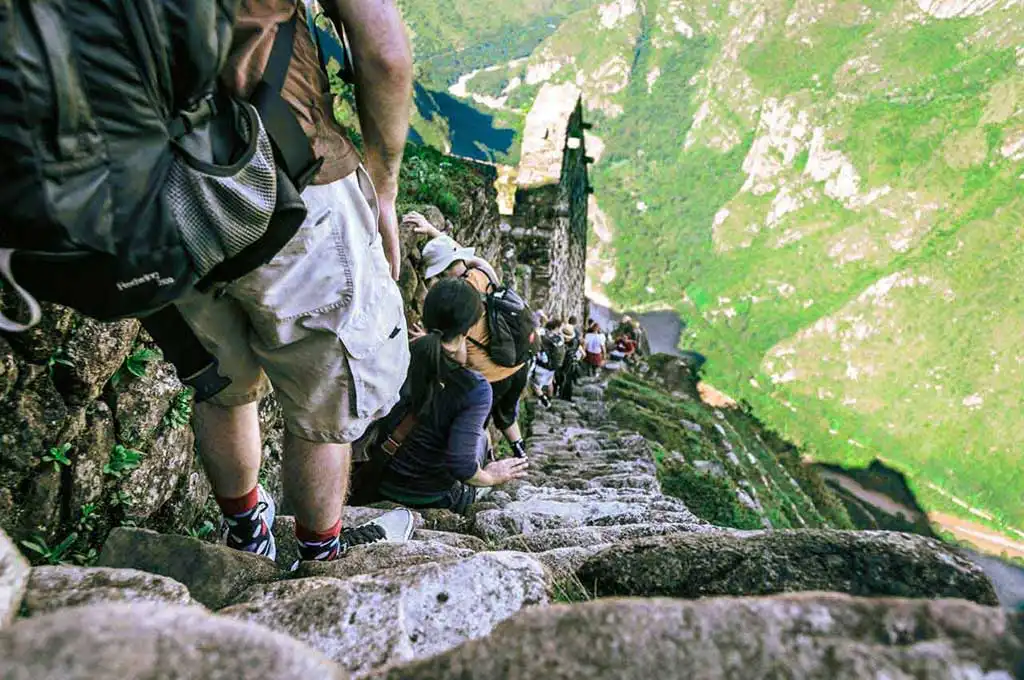
What are the Huayna Picchu Stairs of Death?
During the Huayna Picchu tour you’ll enjoy the climb up the mythical “stairs to heaven,” one of the most iconic parts of the route. The Huayna Picchu stairs of death are one of the most feared and exciting features of the climb to the top of Huayna Picchu mountain. These stairs, made of carved rock, are located in a narrow and steep section of the route, which increases the difficulty of the trek. They are famous for their extreme inclination and the lack of handrails or protections on the sides, which generates a feeling of exposure in those who venture up them.
The Stairs of death Peru: Why are they so famous?
The Huayna Picchu stairs of death are one of the most challenging and exciting routes for adventure lovers. These steep and narrow stairs have been so named because of their difficulty, which makes them a unique experience for the bravest. Along the way, travelers must face high slopes and narrow passages, which makes the ascent a physical and mental challenge.
Many travelers who dare to climb the famous stairs of death in Huayna Picchu have also experienced before the adventure of the inca trail treks, one of the most emblematic treks in Peru. May seem dangerous or deadly, every year thousands of travelers visit the stairs of death just to face the challenge of climbing them and reach the top, where the best view of the entire Inca Empire awaits them.
You may be interested: San Juan Festival in Peru
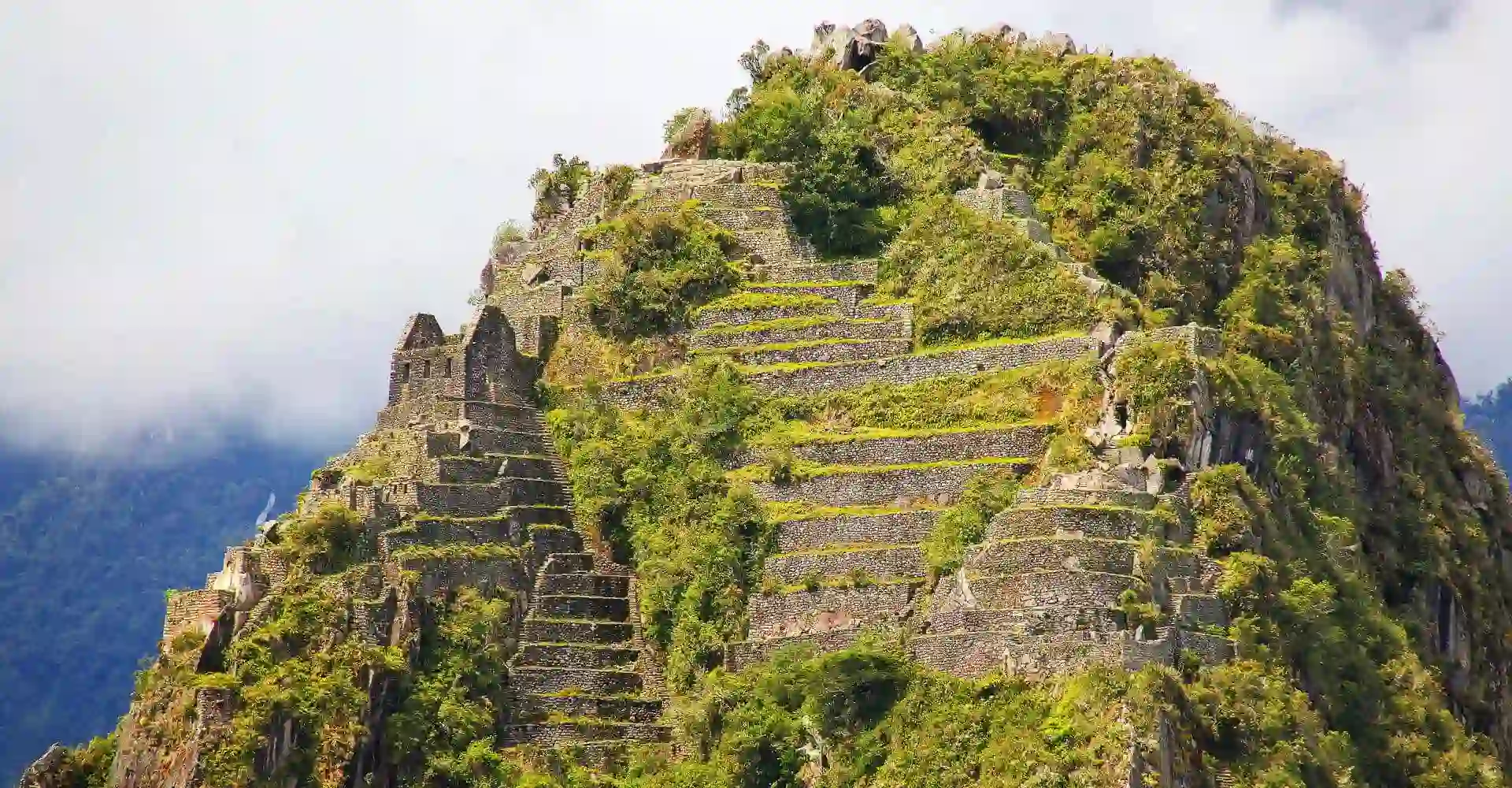
Characteristics of the Stairs of Death
For adventurous travelers heading to Machu Picchu, the climb up Huayna Picchu offers one of the most thrilling and unforgettable experiences in Peru. Nicknamed the “Stairs of Death,” this trail has gained fame not only for its dramatic views but for its intense and historical ascent. Here’s what makes these stairs so unique and memorable.
1. Steep incline that challenges your endurance
The stairs rise sharply along the mountainside, with many sections feeling almost vertical. This steepness demands physical effort and full attention at every step, especially as you climb higher above the valley.
2. Narrow and uneven structure
The steps are narrow, often just wide enough for one person at a time. Many are uneven, with some worn down from centuries of use. This irregularity adds to the thrill and requires careful footing, especially in wet conditions.
3. Built by the Incas over 500 years ago
These aren’t modern steps. The trail is part of the original Inca road network, carved into stone with simple tools. Each step reflects the architectural mastery and spiritual devotion of the Inca civilization.
4. No handrails or modern safety features
Unlike many tourist trails, the Stairs of Death preserve their original structure. There are no railings or barriers along the edge, adding to the sensation of exposure and height. While not inherently dangerous, it requires balance and caution.
5. Surrounded by breathtaking scenery
As you climb, you’re rewarded with panoramic views of the Urubamba River, lush green peaks, and the ruins of Machu Picchu from above. The beauty of the Andes is all around you, making the challenge deeply rewarding.
6. Altitude
Located at over 2,600 meters (8,500 feet) above sea level, the air is thinner and the climb more demanding. It’s important to pace yourself and stay hydrated, especially if you’re not used to high altitudes.
7. Spiritual impact
Many travelers describe reaching the summit of Huayna Picchu as a powerful personal moment. There’s a mix of relief, pride, and awe. Standing where ancient Inca priests once stood connects you to something greater than yourself.
Myths about the Huayna Picchu stairs of death
If you’ve heard of the Huayna Picchu stairs of death, you’ve probably imagined a terrifying, vertical climb with sheer drops and danger at every step. But how much of that is actually true? Let’s clear up some of the most common myths:
1. “People die there all the time.”
This is probably the biggest exaggeration (by their name). While the climb is steep and requires caution, fatalities are extremely rare. Most people who climb Huayna Picchu make it up and down without a problem — especially if they go slow and wear proper footwear.
2. “You need to be an expert climber.”
Nope. You don’t need ropes, climbing gear, or mountaineering experience. The trail is challenging, but it’s a hike, not a technical climb. A basic level of fitness and no fear of heights will get you through just fine.
3. “The stairs are crumbling and unsafe.”
The steps may look intimidating, but they’ve stood for centuries. They’re narrow and uneven, yes — but they’re made of stone and quite solid. Just don’t rush, and always use your hands for support when needed.
4. “You’ll be hanging off a cliff the entire time.”
While there are moments with steep drop-offs and thrilling views, much of the trail is surrounded by vegetation or has handrails or stone walls. If you’re careful, it’s safe and absolutely worth it.
You may be interested: Yawar festival in Peru 2025
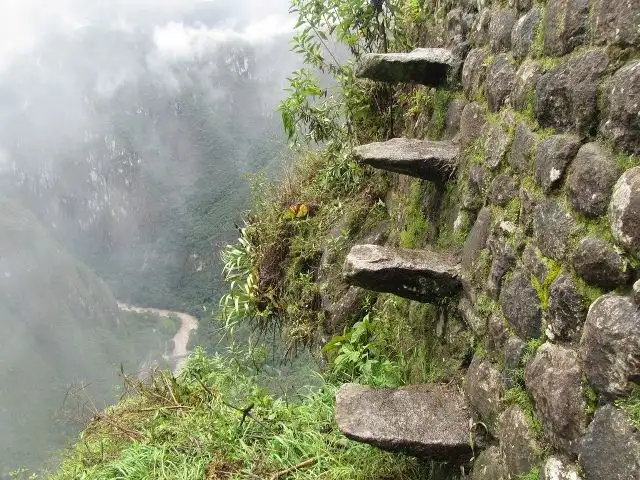
History of Stairs of death in Peru
The Death Stairs at Huayna Picchu have a rich history linked to the Inca civilization. It is believed that they were used by the ancient Incas as an access route to areas of great ceremonial or religious relevance, in addition to being an emergency escape route during the Inca wars, that is, they were a strategy to avoid the arrival of the enemy to the city.
At the time, this route was not only a physical challenge, but also a space of spiritual connection, where rituals of worship to the gods were performed. In addition, the stairway served as part of the complex communication and control system that the Incas implemented in the region.
Sites similar to Huayna Picchu Stairs of death
Now you know that the Huayna picchu straing of death are not the only ones in the world, although if the best known in Latin America, we present other similar places that exist in other parts of the world.
1. El Caminito del Rey (Spain)
Located in Malaga, this ancient path that crosses cliffs has been restored for the enjoyment of adventurers. With suspended walkways and rock walls, its height and history make it as impressive as it is dangerous.
2. The Mount Huashan Plank Walk (China)
Considered one of the most dangerous trails in the world, the “Cliff Walk” on Mount Huashan has wooden platforms embedded in the cliffs, making it a terrifying but unforgettable experience.
3. Pico de Orizaba (Mexico)
Pico de Orizaba, also known as Citlaltépetl, is the highest volcano in Mexico. With a challenging ascent, this site attracts experienced mountaineers looking to tackle its steep routes.
4. The Via Ferrata of the Torre dei Clavari (Italy)
This type of vertical hiking allows hikers to use a system of cables and metal ladders to reach the peaks of the Dolomite Mountains, an experience comparable to the vertiginous stairs of Huayna Picchu.
A similar experience to the Huayna Picchu stairs is the canopy tour on the observation towers that you can enjoy during a tambopata tour 5 days in the jungle, here you will have to overcome your vertigo and launch yourself through the Amazonian territory.
Best time to visit the Huayna Picchu Stairs of death in Peru
If you are thinking of climbing Huayna Picchu and facing its famous “stairs of death”, it is best to plan your visit between May and September. In these months the weather is much drier and more stable, which makes the trail safer and the views really impressive.
June, July and August are ideal for clear skies, although they are also the busiest months. If you prefer to avoid the crowds but still enjoy good weather, May and September are excellent options.
You may be interested: 17 Traditional Peru dances
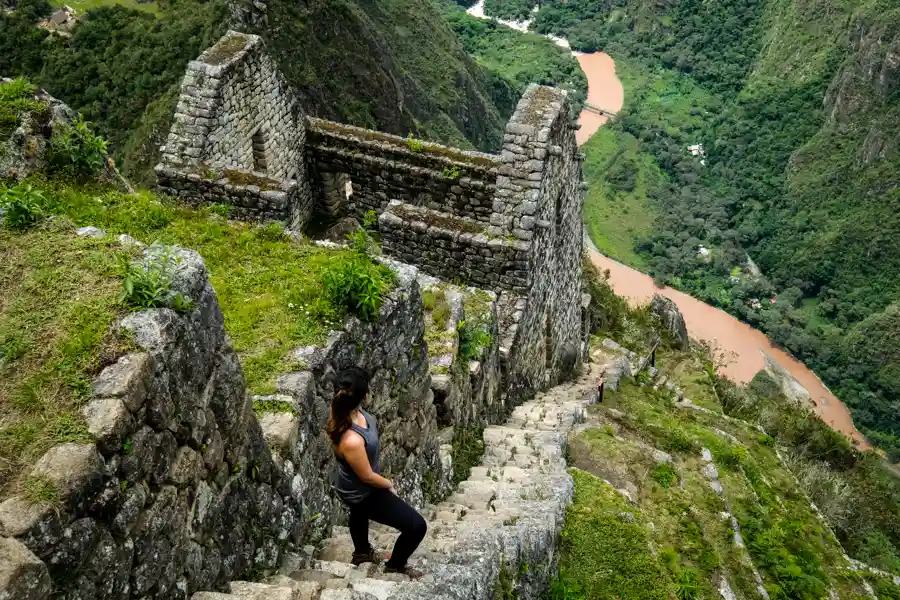
How to travel to Stairs of Death at Machu Picchu
Climbing the Stairs of Death on Huayna Picchu is one of the most daring and challenging adventures in Cusco, but it requires a little more planning due to the remote location and the terrain. Here’s everything you need to know to get there and enjoy this unique experience.
How to get to Huayna Picchu
To get to Huayna Picchu, you must first take a train from Cusco to Aguas Calientes. This is the first step to reach the base of Machu Picchu. From Aguas Calientes, you can take a bus that will take you to the main entrance of Machu Picchu, which is about a 30-minute climb.
From there, you will have to hike to the entrance of Huayna Picchu. The climb is steep and, although not a long one, it does require a good level of physical fitness. To undertake this hike, you need a special permit, which is usually booked well in advance.
Costs and permits
The cost of access to Huayna Picchu is not included in the general admission to Machu Picchu. You must purchase a specific ticket for Huayna Picchu. The entrance fee to Machu Picchu with Huayna Picchu is usually around $70-$100 USD depending on the season. Also, remember that tickets are limited, as only a specific number of people are allowed in per day. It is recommended to purchase tickets at least two months in advance.
The ascent to Huayna Picchu
The ascent to Huayna Picchu is the most difficult part of the trek. The first part will be full of steep stone stairs and narrow paths, which can be frightening for those unused to hiking at high altitudes. You should keep your nerves at bay and wear appropriate footwear and water, as the trek can take between 1 and 2 hours depending on your pace.
As you ascend, panoramic views of the Urubamba Valley and Machu Picchu await you, making the effort well worth it. At the highest point of Huayna Picchu, you can enjoy a spectacular view of the archaeological site, making this trail one of the most popular experiences among adventurers.
It’s an experience that demands both physical and mental endurance. A similar sensation is experienced on the trails of the Colca Canyon, where the paths and viewpoints confront you with heights. If you enjoy this type of challenge, colca canyon tours are a perfect option to continue exploring Peru’s natural majesty.
The descent
The descent from Huayna Picchu is equally challenging, as the steep stairs and slippery terrain require caution. It’s important to take your time and be careful when descending, especially if the weather is wet or rainy, as the risk of slipping is greater.
The descent usually takes around 45 minutes to an hour, depending on your pace. As you descend, you can enjoy the views from the opposite direction and capture different angles of the famous Inca city.
You may be interested: Feast of saints Peter and Paul in Peru
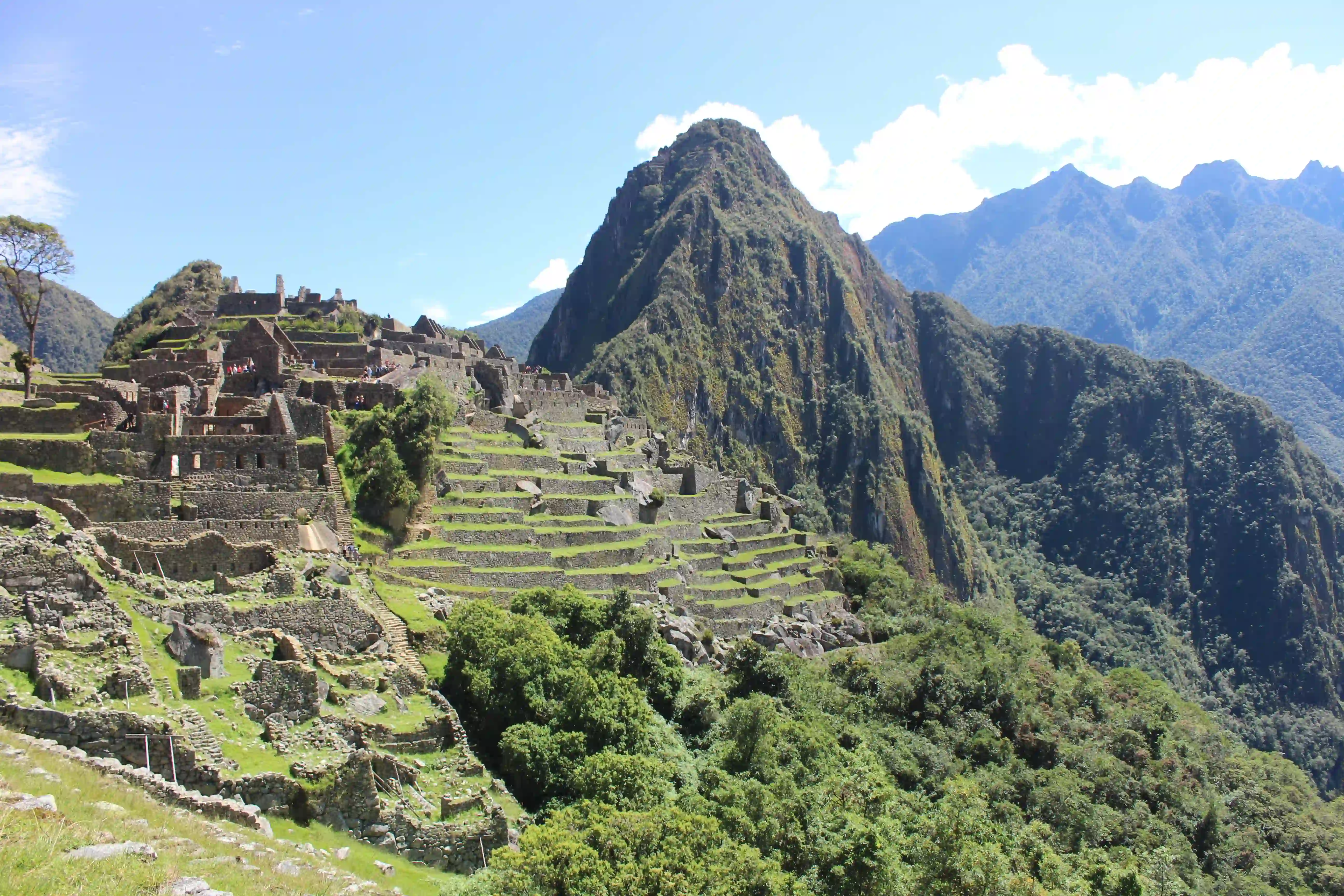
Preparing for the Huayna Picchu stairs of death Peru
Climbing Huayna Picchu isn’t your average walk in the park, but with the right mindset and a bit of preparation, it becomes one of the most rewarding adventures in Peru. Here’s what you need to know before taking on the trail:
What to bring
- Comfortable hiking shoes – Grippy soles are a must. The steps are stone and can get slippery, especially in the early morning or after rain.
- Light backpack – Just the essentials. Remember: the lighter, the better.
- Water bottle – Hydrate before and during the hike. There are no shops or water stations on the trail.
- Snacks – A small energy bar or fruit can give you a much-needed boost at the top.
- Rain jacket or poncho – The weather can change fast in the Andes.
- Sunscreen and hat – Even on cloudy days, the UV rays at that altitude hit hard.
- Camera or phone – You’ll want to capture those once-in-a-lifetime views — just hold on tight when taking photos!
Additional tips
- Use the bathroom beforehand! There are no restrooms once you pass the entry gate.
- Pack light. You’ll thank yourself on the way up.
- Start slow. Don’t race — the stairs are steep, and the altitude can hit harder than expected.
- Respect your limits. It’s okay to take breaks, many parts of the trail have places to rest (and take in the view).
- Don’t forget your entry ticket and ID. They check before letting you in.
- For those who have little time on the Huayna Picchu mountain but do not want to miss the experience of walking the Inca Trail, the 2 days inca trail is the ideal alternative option.
You may be interested: Inca culture in Peru
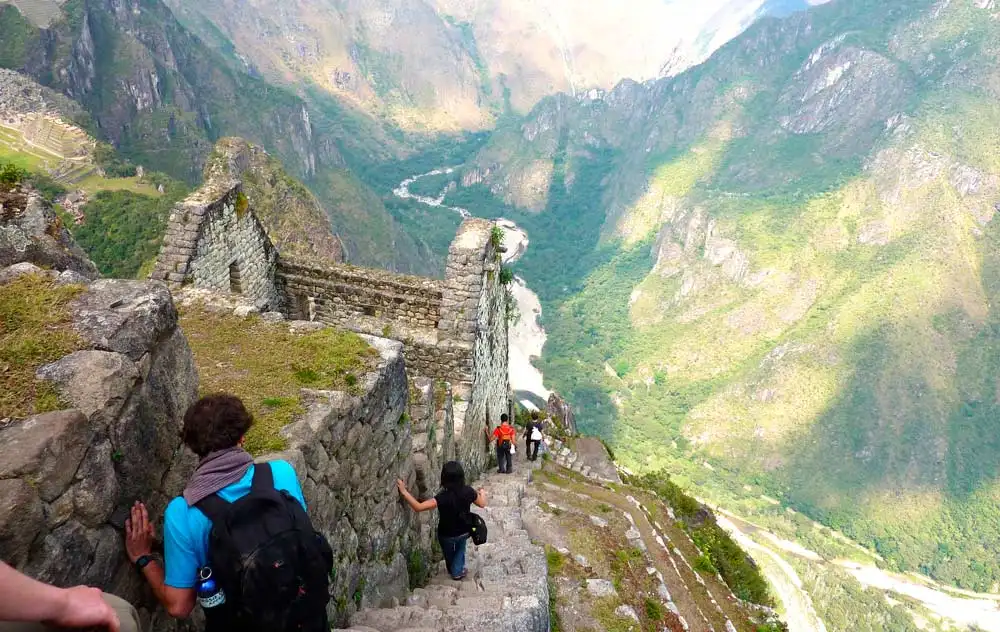
Frequently asked questions about Huayna Picchu Stairs of Death
Thinking about climbing the famous Huayna Picchu “Stairs of Death”? You’re not alone, it’s one of the most thrilling and talked-about hikes in Peru. But with the excitement comes a lot of questions: Is it really that dangerous? How do I get there? When should I book? Here are the most common questions travelers ask before taking on this unforgettable adventure.
1. Is it dangerous to climb the Stairs of Death?
While the ascent of the Death Stairs can be challenging, it is not extremely dangerous if proper precautions are taken. Hikers who do not have vertigo or altitude-related health problems are advised to refrain from this tour.
2. Have people died on the steps of Huayna Picchu?
Although the Stairs of Death on Huayna Picchu are known for their difficulty and steep slopes, there are no official confirmed reports of recent deaths on this specific section.
3. How much does the ticket cost to climb Huayna Picchu stairs of death?
The standard price is around 80 USD, but tickets can be more expensive during high season or when purchased urgently. In addition, it is necessary to purchase a ticket to enter Machu Picchu and reserve the entrance in advance, as spaces are limited.
4. How many hours does it take to climb up and down the Stairs of Death?
The complete ascent to the top of Huayna Picchu, which includes the Death Stairs section, can take between 1.5 and 2 hours. However, it is important to take into account the time needed to rest, enjoy the views and take pictures. The descent can take between 1 and 1.5 hours, depending on the pace.
5. How difficult is the ascent to the Huayna Picchu stairs of death?
The ascent is quite demanding due to the steep stairs and steep slopes. While it is not suitable for beginners or people with mobility problems, experienced trekkers may find it challenging but exciting. Physical preparation and acclimatization
8. What equipment do I need to climb the Death Stairs?
For a safe and comfortable hike, it is essential to bring comfortable and breathable clothing, hiking shoes with good support and grip, sunscreen, water and some light food. It is also advisable to bring a waterproof jacket or cape in case of rain and a camera to capture the breathtaking views.
6. Can I climb the Huayna Picchu stairs of death with children?
The ascent of the Stairs of Death is not suitable for small children or people with mobility problems, as it is a physically demanding section. For younger people or people who prefer easier hikes, there are other routes within Machu Picchu that also offer beautiful views without the challenges of the climb to Huayna Picchu.
| Feature | Description |
|---|---|
| Popular Name | Commonly known as the “Stairs of Death” because of how intimidating they appear, especially to those not used to high or exposed mountain trails. |
| Geographic Location | Found on the steep face of Huayna Picchu, the iconic mountain behind Machu Picchu in many classic images. It lies in Peru’s Cusco region. |
| Elevation | The stairs reach the summit at about 2,720 meters (8,924 ft) above sea level, offering panoramic views of the ancient Inca city below. |
| Construction | Made of stone and carved into the natural rock. Some sections are original Inca construction, while others have been reinforced. Many steps border cliffs. |
| Steepness | The incline becomes extreme near the summit. Some steps are nearly vertical and often require the use of hands to climb safely. |
| Climate Conditions | Located in a cloud forest zone with frequent humidity. Rain and fog are common, and moss makes surfaces slippery. Proper footwear is essential. |
| Level of Difficulty | Considered a challenging hike. Not suitable for those with heart issues, fear of heights, or low physical endurance. |
| Visitor Experience | Many describe the climb as thrilling and nerve-wracking. The mix of fear, beauty, and altitude creates an unforgettable emotional high. |
| Estimated Time to Climb | The round-trip (ascent and descent) usually takes between 1 and 2 hours, depending on weather and the number of people on the trail. |


